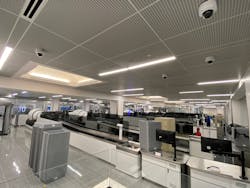2021 Airport Business Project of the Year: Atlanta Expands for Efficiency and Automation
Location: Hartsfield-Jackson Atlanta International Airport
Project: South Security Checkpoint Expansion Project
Cost: $46 million
Completion: November 2020
Key Participants: TSA, New South Synergy, Analogic, L3Harris’ Macdonald Humfrey, TC Architects
Over the course of 2018 and 2019, volume and passenger traffic were up at Hartsfield-Jackson Atlanta International Airport (ATL). Brian Morris, Transportation Security Administration (TSA), recalled, that even with all lanes open, ATL was still experiencing late times. The airport knew it needed to expand and increase efficiency – leading to the South Security Checkpoint Expansion Project (SSCEP).
“You don’t become the world’s most efficient airport by accident, right?” Said Todd McClendon, ATL’s director of central passenger terminal complex. “We don’t want people to miss their flight, we want the screening process to be as pleasant as possible and to get you through that line and on the other side to get onto your flight. This was an opportunity to check all those boxes.”
Design for the project began in 2018, with construction beginning in March of 2020. The checkpoint opened to the public Nov. 17, 2020 – a day ahead of schedule. The project covered more than 30,000 square feet of space that, for the most part, had to remain in operation during the construction.
“The desired date before the Thanksgiving Day holiday rush was to open the checkpoint by November 18, 2020, which was extremely aggressive. It was reopened on November the 17, 2020. I thought it was an impeccable milestone. That was a total team effort from the contractor, TSA and the construction and PM management team,” Chris Rogers, aviation engineer with ATL, said.
The project doubled the size of the existing checkpoint area by adding five screening lanes, new offices, new breakrooms, a breach control unit, employees interlock unit, training rooms, and a remote screening room. In addition, the size of the queuing area was significantly increased, reducing crowding of passengers. The entire renovated space also received new finishes.
One of the key technological upgrades of the project is Analogic’s ConneCT Computed Tomography (CT) Checkpoint Screening System, which replaced the checkpoints former x-ray screening technology. Morris describes the technology as being “light years” ahead of what ATL had before.
“It’s like a CAT scan technology from the medical world applied to your bag. It takes a 3D image of the bag and presents it to you, and you can turn it and rotate it in any access you want to X, Y, and Z, you can zoom into it, just like you can with an iPad on any images that you’re looking at on your own phone. Then, all the tools that’s available to the officer as he sits behind his console, he can strip away any of the organics, he can zoom in on any particular aspect of the bag, and see these images in ways we’ve never been able to before,” said Morris. “It truly is the future.”
Technological upgrades not only made the South Security Checkpoint’s screening lanes more secure, but more efficient for both passengers and employees with the addition of L3Harris’ Macdonald Humfrey Mach-SmartLane Gen2 Automated Screening Lane (ASL)
The system automatically supplies a bin. Passengers walk up and reach down to pull the bin out from underneath, inserts their items and pushes it forward to the new middle section and can walk away – with the automated system doing the rest of the work.
“Previous generation, the TSA, and the passenger had to communicate and try to make a space for their bins to fit group. The new technology allows the passenger to the vest, nest their bin forward, and from there, the MacDonald Humfrey automated screening lane will take it and put it on the conveyor automatically and push it towards the CT so it can get analyzed,” described Morris.
Morris continued that the automation takes away the hassle factor that the original generation had, with passengers trying to push a bin into a space that doesn’t exist. TSA employees also had to take and stack the empty bins after screening, which the system now handles as well.
“This latest generation of technology has a camera built into the back. As a passenger picks up their items out of the bin, a camera analyzes what’s left in the bin, and if that bin is empty, it will automatically put it in stack for you,” Morris said.
The tech is the first in the US to be certified to be used in airports by the TSA. At the beginning of construction, one of the requirements was TSA wanted a single original equipment manufacturer, describes Rogers.
“The airport stepped up to the challenge and they accommodated and they financed or funded the project and purchased equipment, which we’re still working with TSA to get certified. Atlanta was the first to have a full-size certified checkpoint passenger screening system,” said Rogers.
About the Author
Walker Jaroch
Editor
Contact: Walker Jaroch
Editor | AMT
+1-920-568-8399
>> To download the AviationPros media kits, visit: Marketing Resource Center
>>Check out our aviation magazines: Ground Support Worldwide | Airport Business | Aircraft Maintenance Technology

